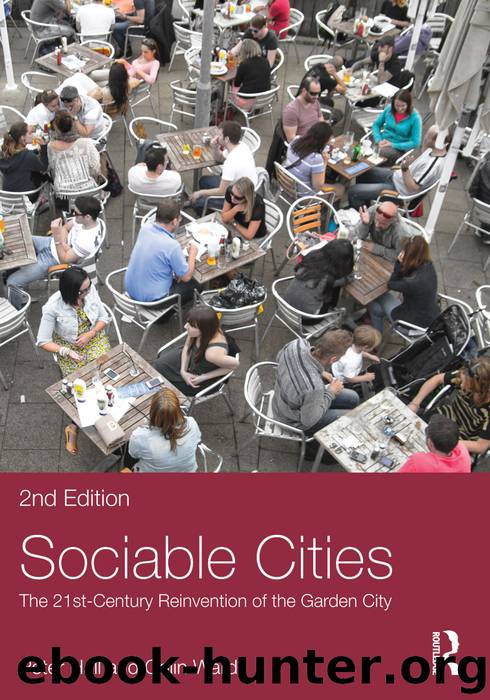SOCIABLE CITIES by Peter Hall & Colin Ward

Author:Peter Hall & Colin Ward
Language: eng
Format: epub
ISBN: 978-1-317-63594-9
Publisher: Routledge
Figure 9.6. Traffic in Keynsham, Somerset. Latest research suggests that car ownership and use may have peaked in London, with its uniquely well-developed public transport offer, but continues to rise elsewhere in the country – a paradox for planners, as people continue to move out of the cities. (Photo: CC Rwendland)
The TCPA response emphasized that it was at least as fully committed to policies of traffic reduction, and to policies to find more urban development land through well-conceived higher-density schemes, as any other interested group. The TCPA portfolio approach fully recognizes the contribution such schemes can make; the Association was particularly supportive of the work of the Urban Villages Forum, which is developing models of sustainable urban development. But we must recognize the limits of the possible, the TCPA warned: ‘The very real danger is that, by pursuing policies and targets that have no prospect of implementation, we achieve a worst-case outcome which is satisfactory to no one’.
The TCPA statement argued that the concept of the Sustainable Social City Region has very real merits. It totally follows the principle of urban compaction, but in a way that does not compromise the quality of urban living and working. It provides for economic activities to function efficiently but sustainably, and for ordinary people to live the lives they want to live. It is based on the principle of regional and sub-regional strategies based on rigorous and even-handed environmental impact assessment; it fully embodies the principle of re-use of urban sites as a priority where appropriate, but gives the necessary flexibility for those cases where other forms of development may be more desirable and may actually deliver greater sustainability benefits. Above all, it implies a programmed approach, in which local authorities make clear their priorities for development at a regional and then at a local scale.
This in turn implies that top-down, regional-level principles need to be blended with bottom-up local perspectives on what is required in any given area. The resulting blend should then make sense in principle and practice. This blending, or portfolio approach, is central to the Social City Region concept.
Building Sustainable Communities: Summing Up
There is, therefore, a whole raft of issues that need to be resolved if we are ever to create sustainable new communities.
The first is to deal head-on with the issue of sustainability, the great planning catchword of the 1990s and 2000s. There is a powerful campaign to the effect that sustainability demands that we maximize building in the cities, and avoid greenfield building save as a last resort. We have just shown that this is not necessary to save land; in Chapter 10, which follows, we look at the argument in terms of other resources, particularly the energy requirements of transport and the polluting emissions that come from it. Then, in Chapter 11, we suggest how it would be possible to produce a portfolio of brownfield and greenfield development, in each region and sub-region, that would satisfy the most rigorous demands of sustainability.
The next question, logically, concerns the mechanics of development: agencies and finance.
Download
This site does not store any files on its server. We only index and link to content provided by other sites. Please contact the content providers to delete copyright contents if any and email us, we'll remove relevant links or contents immediately.
| Anthropology | Archaeology |
| Philosophy | Politics & Government |
| Social Sciences | Sociology |
| Women's Studies |
Nudge - Improving Decisions about Health, Wealth, and Happiness by Thaler Sunstein(7654)
iGen by Jean M. Twenge(5384)
The Fire Next Time by James Baldwin(5379)
Adulting by Kelly Williams Brown(4529)
The Sports Rules Book by Human Kinetics(4339)
The Hacking of the American Mind by Robert H. Lustig(4336)
The Ethical Slut by Janet W. Hardy(4211)
Captivate by Vanessa Van Edwards(3814)
Mummy Knew by Lisa James(3653)
In a Sunburned Country by Bill Bryson(3506)
The Worm at the Core by Sheldon Solomon(3450)
Ants Among Elephants by Sujatha Gidla(3439)
The 48 laws of power by Robert Greene & Joost Elffers(3137)
Suicide: A Study in Sociology by Emile Durkheim(2989)
The Slow Fix: Solve Problems, Work Smarter, and Live Better In a World Addicted to Speed by Carl Honore(2975)
The Tipping Point by Malcolm Gladwell(2864)
Humans of New York by Brandon Stanton(2847)
Handbook of Forensic Sociology and Psychology by Stephen J. Morewitz & Mark L. Goldstein(2676)
The Happy Hooker by Xaviera Hollander(2671)
